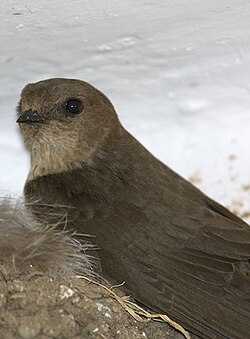Dusky crag martin
| Dusky crag martin | |
|---|---|
 |
|
| Scientific classification | |
| Kingdom: | Animalia |
| Phylum: | Chordata |
| Class: | Aves |
| Order: | Passeriformes |
| Family: | Hirundinidae |
| Genus: | Ptyonoprogne |
| Species: | P. concolor |
| Binomial name | |
|
Ptyonoprogne concolor (Sykes, 1832) |
|
 |
|
|
Approximate range
|
|
| Synonyms | |
|
Hirundo concolor |
|
Hirundo concolor
Cotyle concolor
The dusky crag martin (Ptyonoprogne concolor) is a small passerine bird in the swallow family. It is about 13 cm (5 in) long with a broad body and wings, and a short square tail that has small white patches near the tips of most of its feathers. This martin has sooty-brown upperparts and slightly paler underparts. The two subspecies are resident breeding birds in South Asia from the Indian subcontinent to southwestern China and the northern parts of Thailand, Vietnam and Laos.
This martin nests under a cliff overhang or on a man-made structure, building a neat half-cup mud nest with a soft lining. Both adults incubate the two to four eggs and feed the chicks. This species does not form large breeding colonies, but it is more gregarious outside the breeding season. It feeds a wide variety of insects that are caught as the martin flies near to cliff faces. It may be hunted by large bats as well as birds of prey, but its extensive and expanding range and large population mean that there are no significant conservation concerns.
The dusky crag martin was formally described by in 1832 as Hirundo concolor by British soldier and ornithologist William Henry Sykes. It was moved to the new genus Ptyonoprogne by German ornithologist Heinrich Gustav Reichenbach in 1850. Its nearest relatives are the three other members of the genus, the rock martin P. fuligula, the pale crag martin, P. obsoleta, and the Eurasian crag martin P. rupestris. The genus name is derived from the Greek ptuon (πτύον), "a fan", referring to the shape of the opened tail, and Procne (Πρόκνη), a mythological girl who was turned into a swallow. The specific concolor is from Latin, con "together", and color "colour" and refers to the bird's uniform colouration.
The four Ptyonoprogne species are members of the swallow family of birds, and are classed as members of the Hirundininae subfamily which comprises all swallows and martins except the very distinctive river martins. DNA studies suggest that there are three major groupings within the Hirundininae, broadly correlating with the type of nest built. The groups are the "core martins" including burrowing species like the sand martin, the "nest-adopters", which are birds like the tree swallow that utilise natural cavities, and the "mud nest builders". The Ptyonoprogne species construct an open mud nest and therefore belong to the latter group; Hirundo species also build open nests, Delichon house martins have a closed nest, and the Cecropis and Petrochelidon swallows have retort-like closed nests with an entrance tunnel.
...
Wikipedia

